Surfing is something I’ve wanted to do since high school, especially since I grew up by the beach in Jupiter, Florida where surfing was quite the popular thing to do. I remember thinking that the surfers looked so cool out on the waves with their short boards and dark tans, but I was always too shy to ask any of them if they’d teach me how to do it.
I did get to try it once in 10th grade, of course without any instruction or direction besides “paddle out, turn around, and pop up”, which obviously ended in utter failure. The wave launched me straight into my friend, knocking us both under the powerful waves, and ending my desire to try to learn how to surf.
Fast forward more than ten years later, and I still didn’t know how to surf. I actually never even thought twice about it, and just wrote it off as something that I wanted to learn when I was younger, but now it was probably too late. Then something hit me; I climb mountains, hike through jungles to waterfalls, and paddle board through canyons and caves, why wouldn’t I be able to learn how to stand up on a surfboard and ride a wave still?
So I decided to prove that it’s never too late to learn something you’ve always wanted to do, and looked into surf lessons in the one place that everyone raves about the waves, Costa Rica. I did my usual extreme research on the best places for surf lessons in Costa Rica, and found a program that sounded like it had everything I needed to achieve my goal, Safari Surf School in Nosara. The tiny, hidden gem of a jungle beach town is located on the Pacific side of Costa Rica, where the waves are gentle and warm, and the people live a truly Pura Vida lifestyle.
I was mainly worried that I wasn’t going to have enough time to be able to learn how to stand up on the surfboard (even though I had 8 lessons scheduled), but to my surprise and extreme excitement, I was able to stand and even catch almost every wave on my very first day! It was largely due to the skilled and easy-to-understand directions that the instructors gave me both in and out of the water, plus they’d tell me when a “good wave” was coming, so I knew when to paddle and stand up. But thanks to them and my incredible experience at Safari Surf School, I now have some awesome tips for learning how to surf like a Tica!
Jump To:
1. Take a Few Lessons
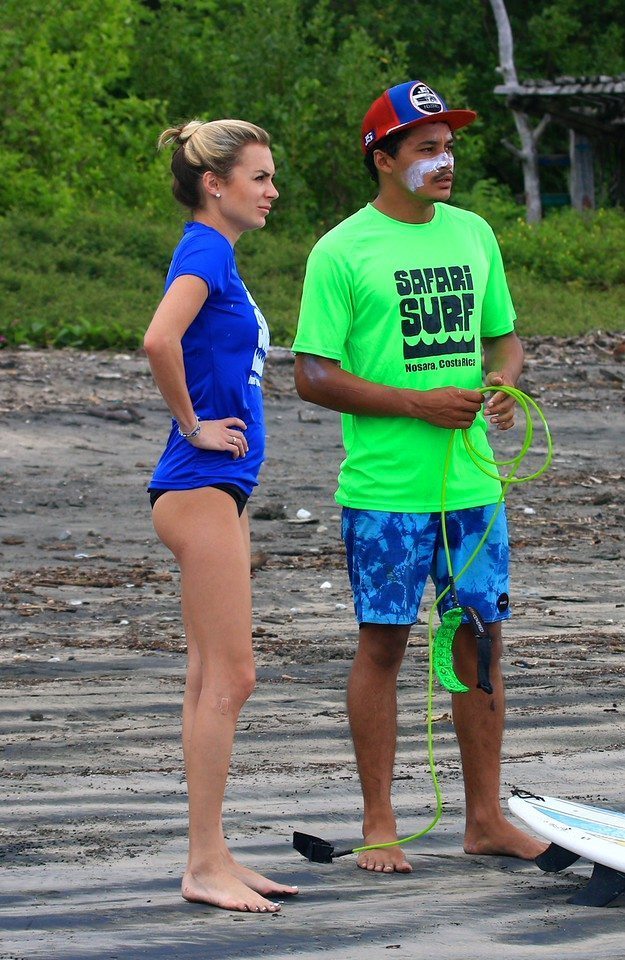
The mistake I made in high school when I was trying to learn how to surf, was that I had no one to actually teach me how to do it. Of course I thought I could just Google instructions, but it’s just not the same as it is with an instructor who can tell you how to do things, and what you need to adjust.
The instructors at Safari Surf School were all beyond awesome, both skill-wise and teacher-wise. They were mostly local Costa Ricans (Ticos) who live in Nosara, and have been surfing for most of their lives. They’ve also been trained to teach other people how to surf, which makes a huge difference from having someone who surfs for fun show you how to do it, because they know how to actually explain it.

I really liked the lessons because the instructors had an easy method of explaining things (through sand pictures, and body form mirroring), and because after each surf attempt they would tell me what I was doing right and what I could adjust. I obviously couldn’t tell that I stick my butt out and lean way too far forward which is what would prevent me from turning, but that’s why it was good to have the instructors watching to tell me to keep my back straight and just bend my knees.
This may be cheating a little bit, but I also did not mind at all that the instructors helped paddle me out to the good waves, helped me find the right ones to catch, and gave me a little push to help with my paddling since I swim about as well as a cat in water.
2. Choose a Board That’s Right For You
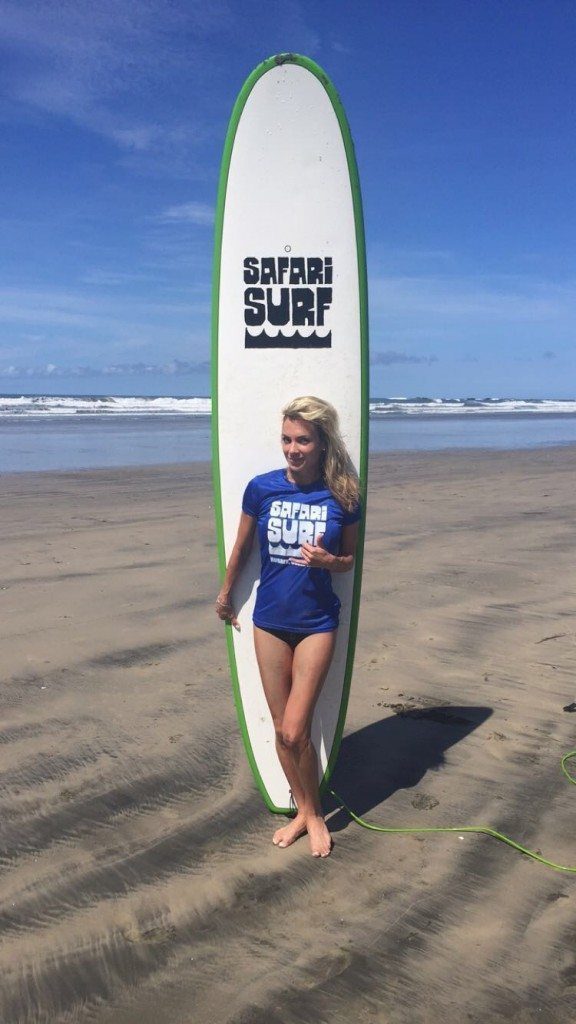
Before I went to Safari Surf School, the most I knew about surfboards was that the longer ones are easier to balance on, and the short boards are harder, but they make you look way cooler. In high school, I would have insisted on starting with a short board, but my semi-cautious 27 year old self decided it was probably best to actually comply with theinstructions, and do what’s best in order to actually learn. Longer boards are good to start with when you’re first learning the techniques to get up on the board, and even how to turn.
Once you’re able to stand up on the long board, and start somewhat turning (they’re a lot harder to turn on because of their size), you can gradually start switching to shorter lengths, until you get down to a short board. You also don’t have to go all the way down to a short board if you’re having fun on a medium or long board, you can just keep using that! I liked the short board because since I’m also short, it was easier for me to handle, and it also went faster and turned sharper than the longer boards.
3. Wear What’s Appropriate or Get Really Annoyed
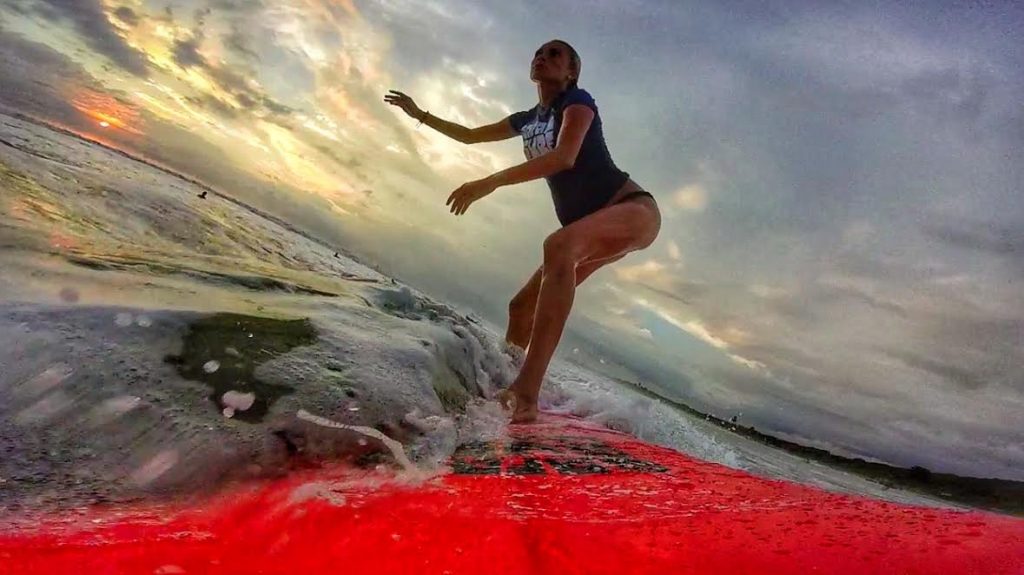
Obviously the second thing that concerned me about learning how to surf (the first being actually getting to stand up), was my bathing suit falling off, or accidentally mooning the instructors behind me. Before I arrived, the Safari Surf School staff sent me all of the information I needed to know what to bring and wear, but you can never be too sure what’s going to stay and what’s going to slip until you start getting pummeled by waves!
They do give you your own rash guard, which is like a t-shirt made of protective material so that you don’t get rashes on your skin from the board and wax. The rash guard is also extremely helpful at preventing any nip slips with bikini tops! I made sure to bring bikinis that I knew would stay on (including a design I had custom made with a style and material that I created to be “travel-proof”), but eventually I got to a day where those ones were still wet, and I had to wear a “fashionable” bikini that I thought would be Ok.
Well, I didn’t have to worry about the top since the rash guard covered me anyway, but the bottoms that I thought were small enough to stay put kept sliding down on either side every time I’d go over or under a wave. Luckily they never exposed too much, but it was beyond annoying having to constantly worry about them, having to pull them up, and readjusting them. If you don’t happen to have your own custom made “travel-proof” swimwear, try to bring some that you know is extra tight or fitting, or that you can tighten on the sides with ties. Just made sure if you wear side-tie bottoms that you double knot them!
Guys can pretty much get away with anything, but suits that are more fitting and not insanely loose might help you balance better, and not have to worry about constantly pulling them down or adjusting them.
4. Learn the Basics Before You Get in the Water
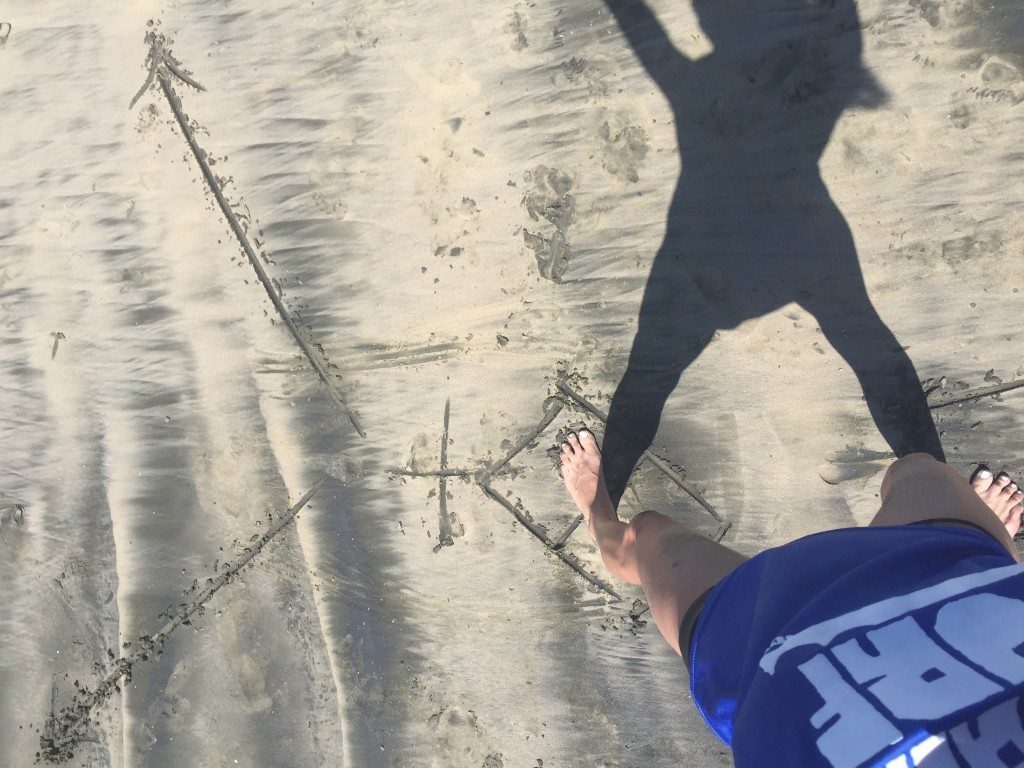
My over-eager ass was definitely ready to hit the waves the second we got out to Playa Guiones the very first day, but my patient, responsible subconscious knew I wasn’t actually ready skill-wise. Even though I like to think that I know how to do everything, I also really wanted to actually learn how to surf the correct way, so paid close attention to my lessons on the shore. The instructors used the sand to list the steps to getting up and drew diagrams around my feet to show me how I should be standing when I turn.
Then they had me practice the techniques a few times on the sand before actually going out into the water, which was helpful since it’s a lot more difficult doing it while getting launched forward by a wave. Learning the techniques before you go out is also helpful because you have time to think, understand, and ask questions, and it’s easier for the instructors to demonstrate what they’re saying. When you’re in the water you’re constantly going over or under a wave, and you obviously can’t really see or practice the body-form techniques since you’re either in the water or laying on the board!
5. How to Stand Up
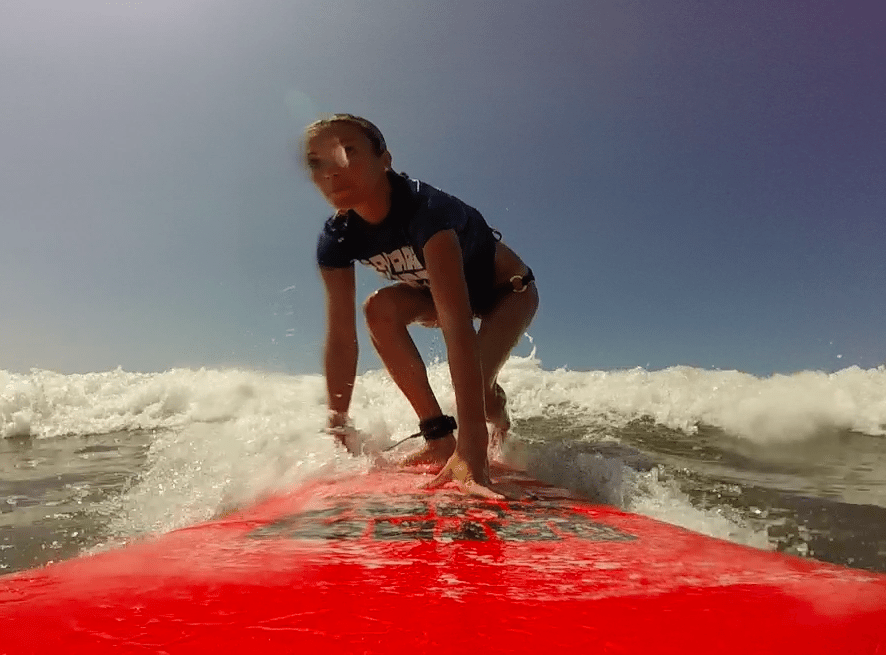
Miraculously, the one thing i didn’t think I was going to be able to do ended up happening the very first time I tried it! I was shocked that the simple instructions and couple of practice tries on the shore actually worked when i tried it in the water! My instructor taught me how to stand up in four basic steps, that actually include “stepping up” instead of “popping up”, which is what I always though you had to do. Here is how they explained the steps to me, and the names they would use to call out when to do them:
Prep: Find the middle of your board (the instructors will draw an X in the wax where your nose or chin should be) and make sure you’re balanced, then look over your left and right shoulders to see which direction the wave is going, and to make sure no one else is already on it or about to catch it behind you (if they are, you have to let them go first and wait for the next one). Then when the wave is about to approach you, you start paddling, then when you feel it push you, take 2-3 more big paddles, then start to stand up.
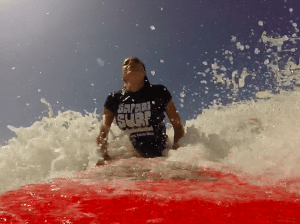
1) Chicken Wings: After your last paddle, place the palms of your hands under your shoulders like you’re about to do a push-up, keeping your elbows in.
2) Cobra: Push your upper body up first, keeping your head high and focused on the direction you want to go in.
3) Back Foot: With your weight still on your arms, bring your back foot up first on the back of the board, and turn it sideways.
4) Front Foot: Then, step your front foot up near your hands, adjust it so that it’s also sideways, bend your knees, straighten your back, and stand up!
6. How to Stay Standing Up
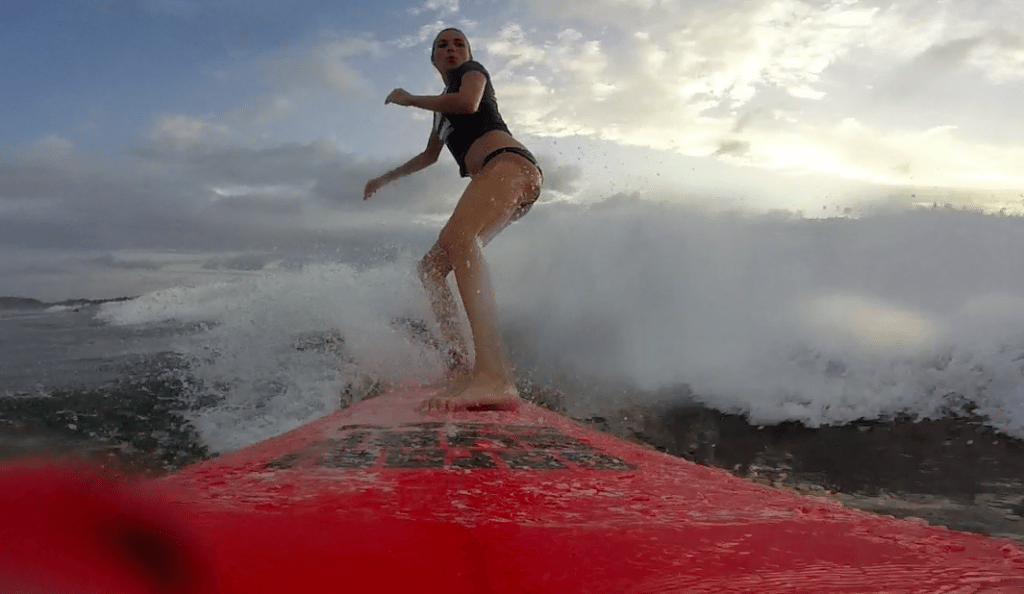
Balancing on a moving surf board did not seem like something I’d be able to do easily, but if you can master the stance you’re supposed to be in, it’s not hard at all! I kind of made up my own stance the first few days, which looked really awkward in pictures, but eventually got the right stance down, which made it a lot easier to stay standing up, and even turning. The trick is to keep your knees bent, and somewhat pushed in towards each other. You might stick your butt out at first, but try to remember to keep your back straight and up right.
You’ll also need to use your arms to keep your balance, so think of them as making an “L”, with your forward arm (this depends on which foot you use forward, “goofy” (right) or “regular (left)) reaching out towards the beach in front of you, or the angle that you’re trying to go in, and the other arm bent slightly in front of you completing the short end of the “L”. When you’re first starting out practicing standing up, you’ll probably practice on the white water, which means you’ll just have to worry about going forward and staying up.
7. How to Look for a “Good Wave”
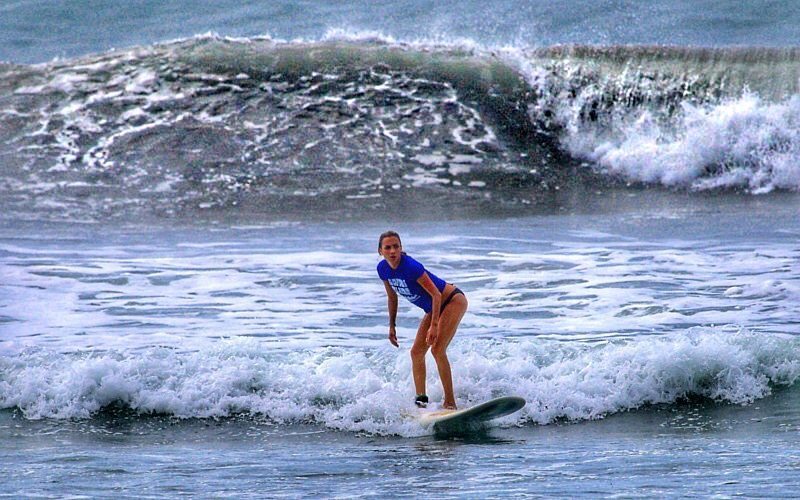
When you look out at the water, you’ll notice that there are two areas where people are surfing in; the one closer to the shore, and the one way past where the waves are breaking. When you’re first learning how to surf, you’ll practice on the white water and smaller waves closer to the shore, because the ones past the breaking point are the massive ones that the pro’s surf on. Those picturesque tall waves that seem to beautifully curl as a surfer rides inside of them are called “green waves”, and are what you want to try to find but in a smaller version closer to the shore.
You can still get some pretty good re-formed mini green waves that come from the bigger ones, you just have to be patient and know what to look for in order to get one. If all you see is white water, or if you see a double wave, you don’t want to take it. What you want to look for is the smooth glassy wave that’s building and starting to curl over far on one side. You don’t want the curling to start too close to you or you’ll just get pummeled in the wave. Instead, you want to take the wave that would put you on its shoulder, so that you can get up and turn, and actually ride it in front of the curling white water.
Once you spot one forming, turn your board around to face the beach, get yourself balanced, and keep looking over your shoulders until it’s about to approach you, then paddle paddle paddle, chicken wings, cobra, back foot, front foot, and up!
8. Turning on a Green Wave
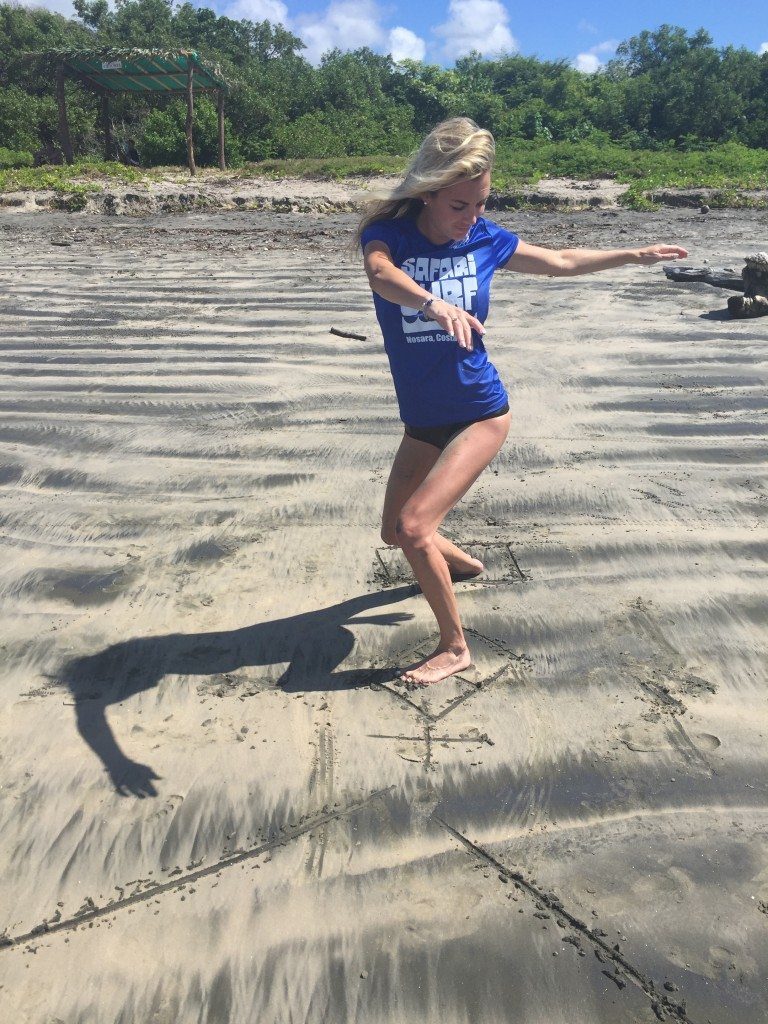
For some reason, it never occurred to me that there’s more to surfing than just standing up and riding the board all the way to the shore. I kind of thought the goal was to be able to make it to the sand still standing, but apparently that’s only the goal when you’re coming back in at the end of the day. As I mentioned above, the “good waves” are the ones that curl, which means you have to be moving sideways in order to stay on it. That means being able to turn the board is extremely important, unless you just want to stick to riding the white water forward.
The instructors taught me the technique for turning on my second day at Safari Surf School. I had heard that my instructor that day was one of the best surfers in Nosara (@KevinMontiel), so I trusted his patient technique lesson that started out on the sand, with him drawing little diagrams around my feet. Essentially what you want to do to turn, is move your upper body about 15 degrees to the left or right, depending on which way the green wave is going.
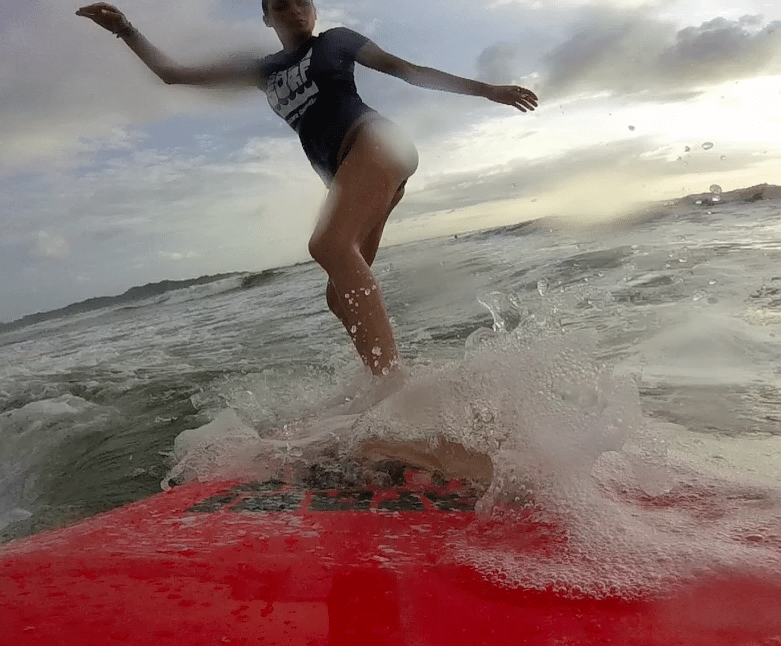
But, in order to do that, you have to remember to keep your knees bent, back straight, and then use your front arm to turn your upper body in the direction that you should be going. The instructors told me to imagine the shore is a clock, you start going towards 12, then if you want to go right, you aim your front hand towards 1:30, if you want to go left, you aim it towards 10:30. You also are supposed to keep your shoulder, head, and gaze all in the same direction as where you are aiming to turn.
Using your hips is also part of the technique, depending on the way you’re standing on your board. If your “regular” (left foot forward), you lean your hips forward to turn right, and back to turn left. If you’re “goofy” (right foot forward), you do the opposite.
9. How to Get Over Waves When Paddling Out
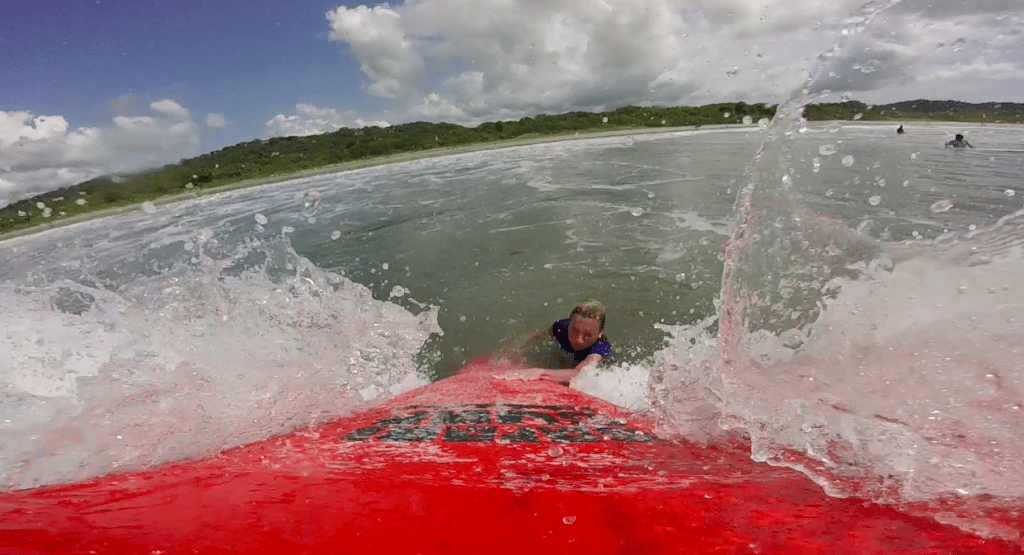
Aside from their expert lessons and overall fun vibe to be around, I really loved having an instructor because I suck at swimming, and they helped me learn how to stand up to the big bad waves. Paddling out is only half of the battle when you’re trying to get out to where the good waves are, the other half is getting past the many waves you aren’t catching on the way. I like to call this part, the part that sucks, because it takes most of your energy, and can be really painful and difficult.
First of all, you have to actually try to get past the non-selected waves, otherwise you’ll just get washed away or pummeled under. The easiest thing to do is to go over them if they’re small enough, or have already turned into white water. To do that, you paddle hard until the wave is about to approach you, then do the Cobra technique and push up hard against the board, so that it goes over the wave and back down, without you going under.
The second technique is called a “Turtle Roll”. What you’re supposed to do, is grab the sides of the board, and turn/flip it over towards the side where your strong arm is, so that you and the board go under and through the oncoming wave. Once you feel the wave go over you, you roll back over, which sounds way easier than it actually is, but is necessary to avoid getting thrown backwards on the board, or taken in the undercurrent.
If an oncoming wave is super big and scary, you can get off the board, attempt holding onto it, and dive under while the wave passes. If anything, you’ll have a leash on, so don’t worry about losing the board, just be concerned with your safety, and make sure to always cover your head if you don’t know what’s going on.
10. How to Handle a Wipe Out
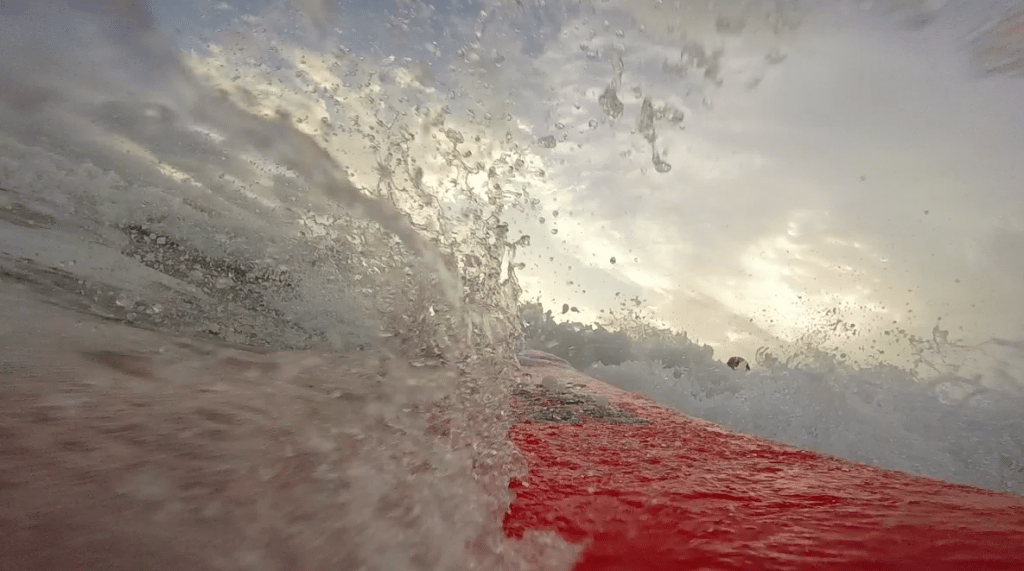
Wipe outs occur when you lose complete balance and control, and either face plant into the water, or get involuntarily thrown off your board by a wave. Obviously, it’s not fun, but it does happen, so you might as well be prepared for it so you don’t get injured. If you feel like you’re about to fall, the best thing to do is usually just jump off, or purposely fall backwards. That way the board will probably still be going forward, and you won’t have to worry as much about it flying down and hitting you, or going head first into the sand.
If you can’t stand up because the nose of your board is going under, it’s best to just roll off to the side and cover your head, and if you get completely thrown off or fall unexpectedly, make sure your number one priority is covering your face and head with your arms. Also, if you happen to feel like you’re getting too close to another surfer while you’re riding a wave, it’s Ok to jump off to avoid potentially hitting them, just make sure you grab the chord of the leash and pull it so that the board doesn’t keep flying towards them as you fly off!

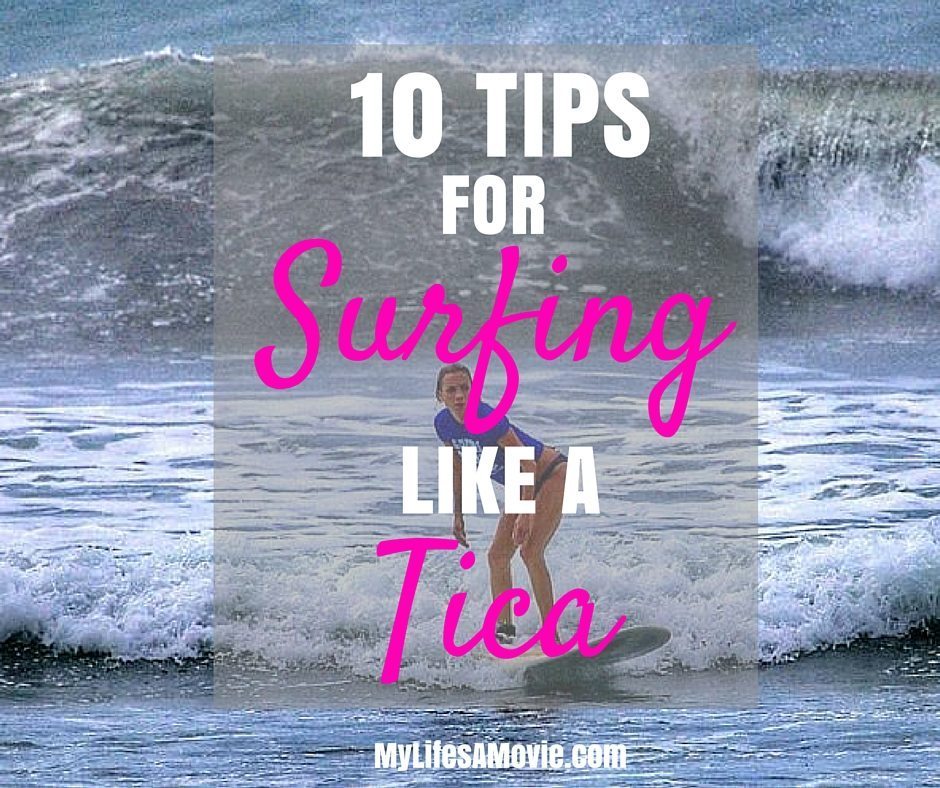
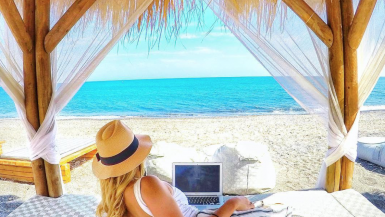
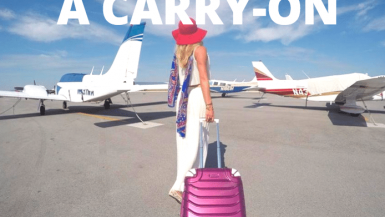

So Happy for You Rocked that Wave!!!!!! ?